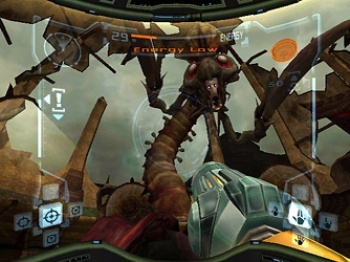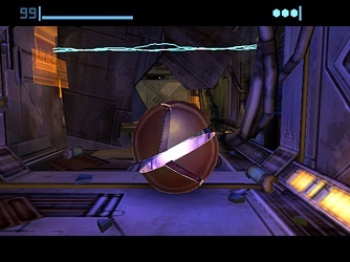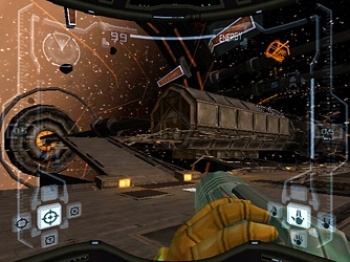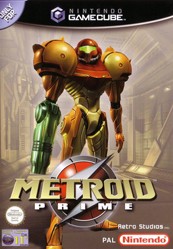Metroid Prime (GameCube) Second Opinion Review
By Jordan Hurst  11.08.2016
11.08.2016

If there was still any doubt after Super Metroid that Nintendo had another top-tier franchise on its hands with Metroid, Metroid Prime soundly shattered it. It's a shining example of how to correctly transition from 2D to 3D, and how to change a beloved series without ruining it - two things developers tend to fail miserably at. The usual structure is still intact. Series protagonist Samus Aran is still wandering alone through a dying world whose every inhabitant generally hates her, she still upgrades her abilities through found power-ups, and the player is still given complete freedom to explore while searching for both story-progressing power-ups and extra ammo and health expansions. Everything else is different.
For starters, it's first-person. The instinctive reaction to that by Metroid fans around the time of the announcement was usually disgust at being lumped in with the stereotypes of general stupidity and hyper-masculinity that are often associated with the FPS genre. Thankfully, those fears turned out to be unfounded. If Metroid Prime is an FPS, it's one of the most intricate, mature FPSs ever made. It's also the series' first outing in 3D, which, in addition to making it very pretty, adds a little more realism to the exploration; no more doors stuck in walls fifty feet above any form of floor. The extra dimension also allows for an unbelievable amount of detail - in visuals and in gameplay. Players can see individual pieces of machinery while navigating through rubble, schools of small fish react to weapons fire while underwater, and fog steams up Samus' visor as she moves through it. More importantly, power-ups are hidden in inventive ways that use all of Samus' abilities in turn.

All of this detail is assisted by the third advancement Metroid Prime makes: the Scan Visor, which is one of the best ideas adventure games were ever introduced to. The inspired function lets the player scan their surroundings - enemies, objects, surfaces, anything - and accrue a mountain of information on it all. At its most basic, it's just used to activate switches and identify things. At a little more advanced stage, it's used to dig up information on enemies and determine their weak points. When the developers are really on the ball, though, you can walk into a room, scan a few things, and know exactly what happened in there prior to entering. Useful entries are stored in a logbook for future reading, as well. Where a lesser game would simply hand out a glossary and say, "Learn everything," this one gives the tools to construct your own glossary and says, "Learn as much as you want! Be as immersed as you want!"
The Scan Visor is essentially how Metroid Prime tells its backstory. Without it, the extent of the plot is that Samus has tracked her long-time enemies, the Space Pirates, to the planet Tallon IV, where she finds them working with a highly radioactive/mutagenic element called Phazon. Basically Super Metroid on a different planet and with mutants - nothing groundbreaking. With it, you can find special "lore" entries from both the Space Pirates and the Chozo (an ancient race that built Samus' power suit and colonised Tallon IV), which detail life on the planet and the Phazon experiments, and foreshadow future combat encounters. It gets especially interesting as the Space Pirates are confronted more and more, and their lore begins to vent about how much they hate Samus and what operations she's disrupted.

The story isn't the only thing that's been borrowed from Super Metroid and then fleshed out. Most of the power-ups are old favourites: beams, missiles, and alternate methods of movement. The latter category includes the Morph Ball, which condenses Samus into a ball to explore small corridors (especially satisfying since it lets you see the graphical details up close), the Space Jump Boots (a double jump), and the magnetic rail-traversing Spider Ball. There are new power-ups, too, steering the game away from the pitfall of being "Super Metroid with new enemies" that Metroid Fusion ran into. The Thermal and X-ray Visors can be used to find hidden items, solve puzzles, and tackle enemies in new ways. There's also the new "beam combo" system, which combines charged beams and missiles for ridiculously strong attacks. Old abilities have gotten new features, too - the Wave Beam activates disabled circuitry, and the Charge Beam sucks in health pickups. Impressively, almost all the tools in this arsenal get equal use in both exploration and combat.

Metroid Prime does have its fair share of combat, if the last few paragraphs of exploration- and Scan Visor-related praise suggested otherwise. The enemies are all wildly varied, including such things as burrowing insects, armoured Space Pirates vulnerable to only one weapon, Chozo Ghosts that fade in and out of corporeality, and a hulking mantis/plant hybrid that's also a hybrid of puzzle and boss. It uses a pretty unorthodox control scheme; the C-Stick changes beams instead of aiming, and the L button controls a very important lock-on function. Indeed, this is the game's only significant fault. For the first few hours, it's very common to accidentally walk into lava or switch to the Power Beam instead of looking up. Thankfully, the difficulty curve is perfect, so by the time the major threats appear, players will be well adjusted.
The game actually makes a determined effort to be appealing to all experience levels. The lock-on system, which at first may seem like a cheat, ends up alleviating many of the control problems faced by console shooters. It also allows the combat to focus more on dodging and timing, as opposed to just blasting everything in sight. In addition to an optional hint system ("optional" being the operative word, there), there's also an unlockable hard mode for veterans. On a final note, though it can be easily overshadowed by everything else, the game has an excellent soundtrack. It expertly switches from atmospheric mood pieces, to peaceful melodies, to upbeat, exotic anthems. Sound effects convey a great deal, too. Hearing a giant, Phazon-mutated Space Pirate laugh from all directions after he turns invisible will send players frantically searching around the room with fear, while the subtle hum of a nearby power-up will have them frantically searching around the room with enthusiasm.

Cubed3 Rating
Exceptional - Gold Award

It's impossible to gush about Metroid Prime too much. It's atmospheric, innovative, diverse, and bursting at the seams with small merits. For anyone that picked up the controller, complained about the control scheme, and then put it down and never touched it again, find the game and give it another chance. It's one of the greatest games ever made.

![]() 9/10
9/10
![]() 10/10
(66 Votes)
10/10
(66 Votes)
 Out now
Out now  Out now
Out now  Out now
Out now  Out now
Out now Comments
Comments are currently disabled

 Sign In
Sign In Game Details
Game Details Subscribe to this topic
Subscribe to this topic Features
Features





 Top
Top

